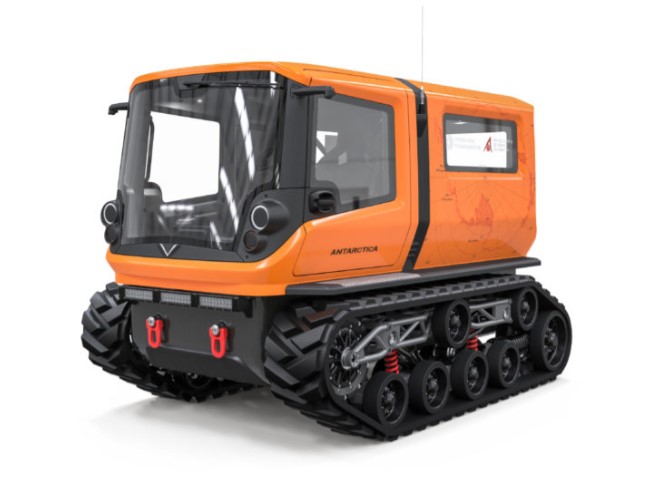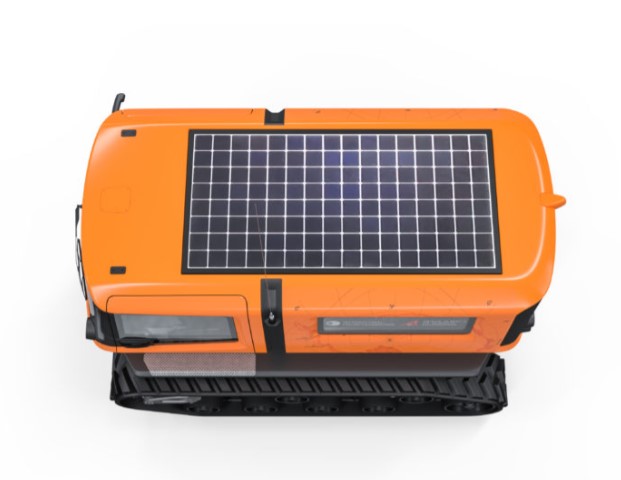Electric vehicle constructor Venturi is set to unveil the next generation of the first-ever zero-emissions polar exploration vehicle.
 In 2009 Venturi’s engineers set to work designing a “zero emissions” solution, to replace combustion-powered vehicles in research settings with extreme conditions. As early as 2010, an early concept model was unveiled on Venturi’s stand at the Paris Motor Show. In 2018, the next generation electric polar exploration vehicle was formally unveiled.
In 2009 Venturi’s engineers set to work designing a “zero emissions” solution, to replace combustion-powered vehicles in research settings with extreme conditions. As early as 2010, an early concept model was unveiled on Venturi’s stand at the Paris Motor Show. In 2018, the next generation electric polar exploration vehicle was formally unveiled.
The drivetrain of this third generation model was designed by a specialist supplier, who previously worked on the earlier concept vehicles. The two 60kW engines – one per track – use axial rather than radial flow technology. These two motors are highly compact, relatively lightweight, and offer high torque at low RPM. This means they generate their maximum yield at low speeds, making for a more comfortable driving experience and allowing the vehicle to extricate itself more easily from tricky situations.

The electric engines also act as brakes (one of the unique features of an electric machine), simultaneously allowing the battery to regenerate its cells. Antarctica is, however, also equipped with non-mechanical brake-by-wire technology, mainly used when the batteries are already fully charged (and do not need to recover any additional energy) or when the situation requires. The brake management program developed by Venturi comes straight from Formula E. The teams also drew on their previous experience with the Voxan Wattman (record-breaking electric motorcycle) to explore other program of this software package directly linked to engine operation.
Battery power
The power capacity, functions, and performance of batteries already developed by Venturi and its partners provided a perfect starting point. Next, improvements were added: “Because the third generation Antarctica is bigger, we were able to work with a battery with more cells,” explains Franck Baldet. “The batteries we are using are made in Austria, by one of our suppliers specializing in prototyping. The basic design chosen was adapted to our specific needs. The ideal running temperature for a battery is around 20 degrees, whereas we are going to be driving at -50°C. So we had to rethink a lot of things.”
This third generation Antarctica promises a range of 50km, whatever the external temperature. One of the challenges was also to find ways to preserve the batteries when recharging in very cold conditions, as this causes the cells to age more quickly. The priority here is not fast charging, but rather maximizing the battery’s thermal operating limits, extending its lifetime to suit the nature of the vehicle’s mission.
“To maintain the battery in the best possible conditions, we installed an electric heater,” explains Louis Marie Blondel.
“It can be powered either by the battery itself, or via an external connection, or by solar panel. So the vehicle keeps itself at the right temperature, and that’s where we see the importance of the insulation, which directly impacts energy requirements.”

The Antarctica can be powered via a solar panel
To optimize energy management, Venturi is also using parts taken from Formula E, such as the vehicle’s control unit which manages all of Antarctica’s functions, and uses program developed in the world of motorsport, particularly for managing power flows. In milder temperatures, and although the vehicle has been designed for cold conditions, the thermal stability of the systems and batteries can be maintained by means of “cold plates” above the tracks, through which a coolant is circulated.
The Venturi Antarctica, the first-ever electric polar exploration vehicle, is now to set to continue its testing program. Trials and measurements will be conducted in a mountain environment in the ProvenceAlpes-Côte-d’Azur. The vehicle will be put through its paces, overcoming obstacles such as tree trunks and performing particular maneuvers. High intensity acceleration and braking tests will also be carried out. All of these tests have already been done in the simulator, but will now be repeated in real-world conditions.
Other dynamic trials will be conducted in climate-controlled chambers at -50°C, to simulate true polar conditions. These will test the efficacy of the insulation, and ensure that all of the on-board electronics continue to function correctly. Antarctica will then continue its journey to distant lands, and the polar exploration bases that are its ultimate destination.
Published: December 21, 2022